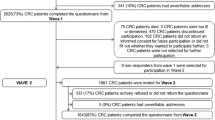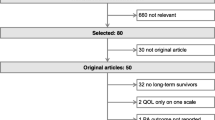Abstract
Purpose
The impact of cancer on quality of life and depression is an important issue. The purpose of this study was to identify the impact of physical fitness on quality of life and depression in stage II–III colorectal cancer survivors.
Methods
Participants in the current study included 122 stage II–III colorectal cancer survivors (57 females; 56.67 ± 9.16 years of age and 55 males; 54.69 ± 9.78 years of age). Fitness was assessed using the 6-min walk test, chair stand test, and push-up test. Quality of life and depression were measured using the Functional Assessment of Cancer Therapy-Colorectal (FACT-C) scale and a 9-item patient health questionnaire interview, respectively.
Results
There was a significant association between physical fitness and quality of life and depression in colorectal cancer survivors. The 6-min walk test results were associated with FACT-C total (r = 0.298, p < 0.05), physical well-being (r = 0.230, p < 0.05), functional well-being (r = 0.234, p < 0.05), colorectal cancer concern (r = 0.229, p < 0.05), and depression (r = −0.228, p < 0.05), and the chair stand test results were associated with functional well-being (r = 0.231, p < 0.05), colorectal cancer concern (r = 0.242, p < 0.05), and depression (r = −0.227, p < 0.05) even after controlling for all potentially confounding variables. A multiple regression analysis indicated that the 6-min walk was a significant predictor of health-related quality of life, and participants in the lowest tertile of the 6-min walk test results had lower quality of life and greater depression than those in the highest tertile.
Conclusion
Improving and maintaining physical fitness are important for quality of life and depression in stage II–III colorectal cancer survivors.

Similar content being viewed by others
References
Ferlay J, Shin HR, Bray F, Forman D, Mathers C, Parkin DM (2010) Estimates of worldwide burden of cancer in 2008: GLOBOCAN 2008. Int J Cancer J Int Cancer 127(12):2893–2917. doi:10.1002/ijc.25516
Denlinger CS, Engstrom PF (2011) Colorectal cancer survivorship: Movement matters. Cancer Prev Res (Phila) 4(4):502–511. doi:10.1158/1940-6207.CAPR-11-0098
Mitchell AJ, Chan M, Bhatti H, Halton M, Grassi L, Johansen C, Meader N (2011) Prevalence of depression, anxiety, and adjustment disorder in oncological, haematological, and palliative-care settings: a meta-analysis of 94 interview-based studies. Lancet Oncol 12(2):160–174. doi:10.1016/S1470-2045(11)70002-X
Brown JK, Byers T, Doyle C, Coumeya KS, Demark-Wahnefried W, Kushi LH, McTieman A, Rock CL, Aziz N, Bloch AS, Eldridge B, Hamilton K, Katzin C, Koonce A, Main J, Mobley C, Morra ME, Pierce MS, Sawyer KA, American Cancer S (2003) Nutrition and physical activity during and after cancer treatment: an American Cancer Society guide for informed choices. CA Cancer J Clin 53(5):268–291
Courneya KS, Friedenreich CM, Quinney HA, Fields AL, Jones LW, Fairey AS (2003) A randomized trial of exercise and quality of life in colorectal cancer survivors. Eur J Cancer Care 12(4):347–357
Karvinen KH, Courneya KS, North S, Venner P (2007) Associations between exercise and quality of life in bladder cancer survivors: a population-based study. Cancer Epidemiol Biomark Prev Publ Am Assoc Cancer Res Cosponsored Am Soc Prev Oncol 16(5):984–990. doi:10.1158/1055-9965.EPI-06-0680
Craft LL, Vaniterson EH, Helenowski IB, Rademaker AW, Courneya KS (2012) Exercise effects on depressive symptoms in cancer survivors: a systematic review and meta-analysis. Cancer Epidemiol Biomarkers Prev 21(1):3–19. doi:10.1158/1055-9965.EPI-11-0634
Schmitz KH, Holtzman J, Courneya KS, Masse LC, Duval S, Kane R (2005) Controlled physical activity trials in cancer survivors: a systematic review and meta-analysis. Cancer Epidemiol Biomarkers Prev 14(7):1588–1595. doi:10.1158/1055-9965.EPI-04-0703
Lynch BM, Cerin E, Owen N, Hawkes AL, Aitken JF (2008) Prospective relationships of physical activity with quality of life among colorectal cancer survivors. J Clin Oncol Off J Am Soc Clin Oncol 26(27):4480–4487. doi:10.1200/JCO.2007.15.7917
Thorsen L, Skovlund E, Stromme SB, Hornslien K, Dahl AA, Fossa SD (2005) Effectiveness of physical activity on cardiorespiratory fitness and health-related quality of life in young and middle-aged cancer patients shortly after chemotherapy. J Clin Oncol 23(10):2378–2388. doi:10.1200/JCO.2005.04.106
Otto SJ, Korfage IJ, Polinder S, van der Heide A, de Vries E, Rietjens JA, Soerjomataram I (2014) Association of change in physical activity and body weight with quality of life and mortality in colorectal cancer: a systematic review and meta-analysis. Support Care Cancer. doi:10.1007/s00520-014-2480-0
Thomas E, Frost G, Harrington T, Bell J (2001) Validation of ‘InBody’Bioelectrical Impedance by Whole Body MRI. Laboratory report
Yoo HJ, Kim JC, Eremenco S, Han OS (2005) Quality of life in colorectal cancer patients with colectomy and the validation of the Functional Assessment of Cancer Therapy-Colorectal (FACT-C), Version 4. J Pain Symptom Manag 30(1):24–32. doi:10.1016/j.jpainsymman.2004.12.009
Kroenke K, Spitzer RL, Williams JB (2001) The PHQ-9: Validity of a brief depression severity measure. J Gen Intern Med 16(9):606–613
Jansen L, Koch L, Brenner H, Arndt V (2010) Quality of life among long-term (>/=5 years) colorectal cancer survivors–systematic review. Eur J Cancer 46(16):2879–2888. doi:10.1016/j.ejca.2010.06.010
Gujral S, Avery KN, Blazeby JM (2008) Quality of life after surgery for colorectal cancer: clinical implications of results from randomised trials. Support Care Cancer 16(2):127–132. doi:10.1007/s00520-007-0356-2
Demers C, McKelvie RS, Negassa A, Yusuf S, Investigators RPS (2001) Reliability, validity, and responsiveness of the six-minute walk test in patients with heart failure. Am Heart J 142(4):698–703. doi:10.1067/mhj.2001.118468
Arndt V, Merx H, Stegmaier C, Ziegler H, Brenner H (2004) Quality of life in patients with colorectal cancer 1 year after diagnosis compared with the general population: a population-based study. J Clin Oncol 22(23):4829–4836. doi:10.1200/JCO.2004.02.018
Stommel M, Kurtz ME, Kurtz JC, Given CW, Given BA (2004) A longitudinal analysis of the course of depressive symptomatology in geriatric patients with cancer of the breast, colon, lung, or prostate. Health Psychol 23(6):564–573. doi:10.1037/0278-6133.23.6.564
Deimling GT, Sterns S, Bowman KF, Kahana B (2005) The health of older-adult, long-term cancer survivors. Cancer Nurs 28(6):415–424
Schneider EC, Malin JL, Kahn KL, Ko CY, Adams J, Epstein AM (2007) Surviving colorectal cancer: Patient-reported symptoms 4 years after diagnosis. Cancer 110(9):2075–2082. doi:10.1002/cncr.23021
Ramsey SD, Berry K, Moinpour C, Giedzinska A, Andersen MR (2002) Quality of life in long term survivors of colorectal cancer. Am J Gastroenterol 97(5):1228–1234. doi:10.1111/j.1572-0241.2002.05694.x
Klemm P, Miller MA, Fernsler J (2000) Demands of illness in people treated for colorectal cancer. Oncol Nurs Forum 27(4):633–639
Polat U, Arpaci A, Demir S, Erdal S, Yalcin S (2014) Evaluation of quality of life and anxiety and depression levels in patients receiving chemotherapy for colorectal cancer: Impact of patient education before treatment initiation. J Gastrointest Oncol 5(4):270–275. doi:10.3978/j.issn. 2078-6891.2014.034
Swellengrebel HA, Marijnen CA, Verwaal VJ, Vincent A, Heuff G, Gerhards MF, van Geloven AA, van Tets WF, Verheij M, Cats A (2011) Toxicity and complications of preoperative chemoradiotherapy for locally advanced rectal cancer. Br J Surg 98(3):418–426. doi:10.1002/bjs.7315
Marijnen CA, Kapiteijn E, van de Velde CJ, Martijn H, Steup WH, Wiggers T, Kranenbarg EK, Leer JW, Cooperative Investigators of the Dutch Colorectal Cancer G (2002) Acute side effects and complications after short-term preoperative radiotherapy combined with total mesorectal excision in primary rectal cancer: report of a multicenter randomized trial. J Clin Oncol 20(3):817–825
West MA, Loughney L, Barben CP, Sripadam R, Kemp GJ, Grocott MP, Jack S (2014) The effects of neoadjuvant chemoradiotherapy on physical fitness and morbidity in rectal cancer surgery patients. Eur J Surg Oncol. doi:10.1016/j.ejso.2014.03.021
Peddle CJ, Au HJ, Courneya KS (2008) Associations between exercise, quality of life, and fatigue in colorectal cancer survivors. Dis Colon Rectum 51(8):1242–1248. doi:10.1007/s10350-008-9324-2
Buffart LM, De Backer IC, Schep G, Vreugdenhil A, Brug J, Chinapaw MJM (2013) Fatigue mediates the relationship between physical fitness and quality of life in cancer survivors. J Sci Med Sport 16(2):99–104. doi:10.1016/j.jsams.2012.05.014
Karvinen KH, Courneya KS, North S, Venner P (2007) Associations between exercise and quality of life in bladder cancer survivors: a population-based study. Cancer Epidem Biomar 16(5):984–990. doi:10.1158/1055-9965.Epi-06-0680
Dishman RK, Berthoud HR, Booth FW, Cotman CW, Edgerton VR, Fleshner MR, Gandevia SC, Gomez-Pinilla F, Greenwood BN, Hillman CH, Kramer AF, Levin BE, Moran TH, Russo-Neustadt AA, Salamone JD, Van Hoomissen JD, Wade CE, York DA, Zigmond MJ (2006) Neurobiology of exercise. Obesity 14(3):345–356. doi:10.1038/oby.2006.46
Matta Mello Portugal E, Cevada T, Sobral Monteiro-Junior R, Teixeira Guimaraes T, da Cruz RE, Lattari E, Blois C, Camaz Deslandes A (2013) Neuroscience of exercise: from neurobiology mechanisms to mental health. Neuropsychobiology 68(1):1–14. doi:10.1159/000350946
Nijs J, Meeus M, Versijpt J, Moens M, Bos I, Knaepen K, Meeusen R (2014) Brain-derived neurotrophic factor as a driving force behind neuroplasticity in neuropathic and central sensitization pain: a new therapeutic target? Exp Opin Ther Targets 18:1–12. doi:10.1517/14728222.2014.994506
Ferris LT, Williams JS, Shen CL (2007) The effect of acute exercise on serum brain-derived neurotrophic factor levels and cognitive function. Med Sci Sports Exerc 39(4):728–734. doi:10.1249/mss.0b013e31802f04c7
Marusiak J, Zeligowska E, Mencel J, Kisiel-Sajewicz K, Majerczak J, Zoladz JA, Jaskolski A, Jaskolska A (2014) Interval training-induced alleviation of rigidity and hypertonia in patients with Parkinson's disease is accompanied by increased basal serum brain-derived neurotrophic factor. J Rehabil Med. doi:10.2340/16501977-1931
Costa HS, Lima MM, Silva MG, Alencar MC, Nunes MC, Camargos ER, Martinelli PM, Rocha MO (2014) Effect of acute aerobic exercise on serum BDNF levels in patients with Chagas heart disease. Int J Cardiol 174(3):828–830. doi:10.1016/j.ijcard.2014.04.136
Acknowledgments
National Research Foundation of Korea (NRF) (No. 2013K2A1A2054437) and the National R & D program for Cancer Control, Ministry of Health and Welfare, Republic of Korea (1120230).
Conflict of interest
No author has declared conflicts of interest. The authors have full control of all primary data and we agree to allow the journal to review the data if required.
Contribution
The authors’ responsibilities were as follows: JJ, NK, HH, JWL, and SC contributed to designing the study; JL, MK SH, JY, HP, MO, HY, DWK, JP, and DIK collected the data; JJ, SH, and JL analyzed the data; JL and JJ wrote the manuscript; and JL, HY, and DWK confirmed the accuracy of the data and the analyses.
Author information
Authors and Affiliations
Corresponding authors
Electronic supplementary material
Below is the link to the electronic supplementary material.
ESM 1
(DOCX 30 kb)
Rights and permissions
About this article
Cite this article
Lee, J., Lee, M., Hong, S. et al. Association between physical fitness, quality of life, and depression in stage II–III colorectal cancer survivors. Support Care Cancer 23, 2569–2577 (2015). https://doi.org/10.1007/s00520-015-2615-y
Received:
Accepted:
Published:
Issue Date:
DOI: https://doi.org/10.1007/s00520-015-2615-y




